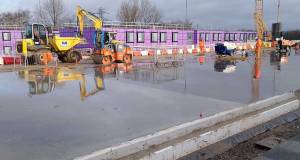
- Marketplace
- Posted
Ecocel on site with 56 homes in Cork
Irish cellulose insulation manufacturer Ecocel is currently on site completing the installation of its cellulose insulation to a new social housing development in County Cork.
This article was originally published in issue 38 of Passive House Plus magazine. Want immediate access to all back issues and exclusive extra content? Click here to subscribe for as little as €10, or click here to receive the next issue free of charge
Beechwood, Clonakilty is a scheme of 56 dwellings, incorporating new houses plus apartments in a converted stone building.
The installation of 330 mm of Ecocel in the roof of each dwelling is achieving a U-value of 0.11, John Egan of Ecocel told Passive House Plus. “Besides thermal performance, Ecocel also offers a number of other key benefits including excellent fire protection and a very low carbon footprint.
“And because it is blown in, installation is also highly efficient. We started on a Tuesday morning and by Friday morning we had completed 16 houses, insulating over 900 m2 of floor area.”
Ecocel is manufactured in Cork City from recycled newspaper. “Because the material is blown, rather than laid out, it fills every nook and cranny and ensures a quality installation that completely fills the space being insulated,” Egan said.
“Attic insulation is often overlooked compared to more complex building fabric solutions, but it is the simplest, most effective way to save energy in a dwelling. A U-value of 0.11 should be the minimum requirement. Heat rises, so zero heat loss through the attic should be our goal.
“People sometimes think they can simply roll out attic insulation themselves, but quality expert installation is important here too to ensure it functions effectively to achieve zero heat loss.”
The dwellings at Beechwood are all constructed from cavity block walls and built to the NZEB standard, with air source heat pumps as the main form of space heating.
Egan added: “We also think it’s important that the energy performance of houses is tested after five years and ten years. At the moment we are relying on predictions of energy performance, we are not testing real time energy performance. We believe that the thermal performance of Ecocel improves over time as the material settles and becomes more dense.”
Related items
-
 New Ejot profile cuts thermal bridging losses by 25mm insulation equivalent
New Ejot profile cuts thermal bridging losses by 25mm insulation equivalent -
 Build Homes Better updates Isoquick certification to tackle brick support challenge
Build Homes Better updates Isoquick certification to tackle brick support challenge -
 Ecological Building Systems expands UK and Irish straw panel construction with EcoCocon deal
Ecological Building Systems expands UK and Irish straw panel construction with EcoCocon deal -
 Grant’s Aerona R290: A next-gen heat pump designed for the Irish climate
Grant’s Aerona R290: A next-gen heat pump designed for the Irish climate -
 Historic Dublin building retrofitted with cutting edge insulation
Historic Dublin building retrofitted with cutting edge insulation -
 Proctor gains ground with Scottish passive schools
Proctor gains ground with Scottish passive schools

